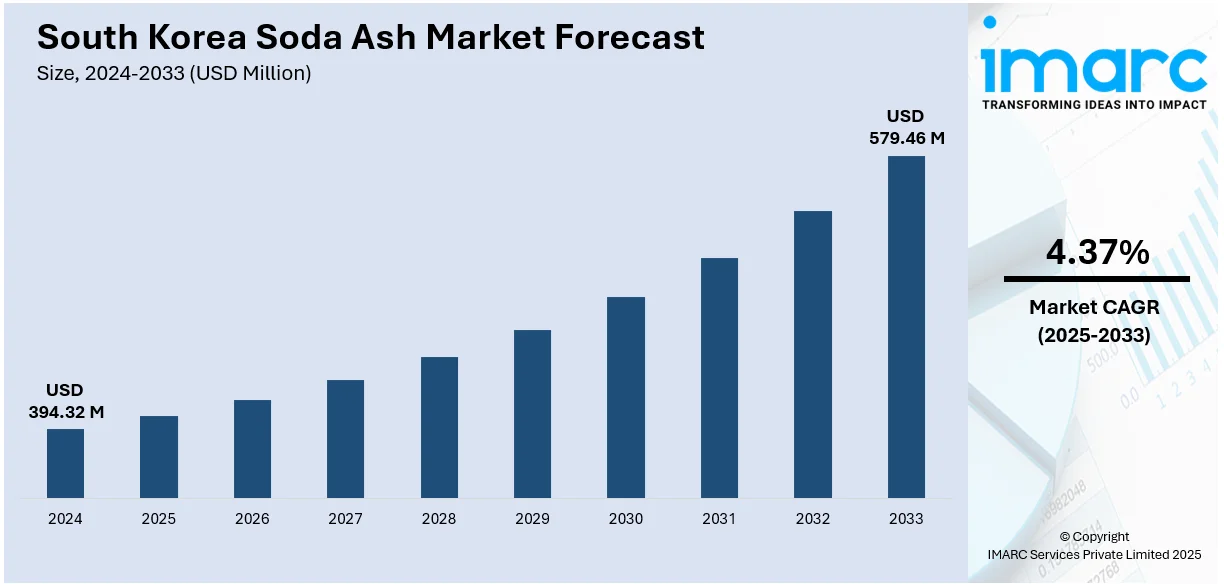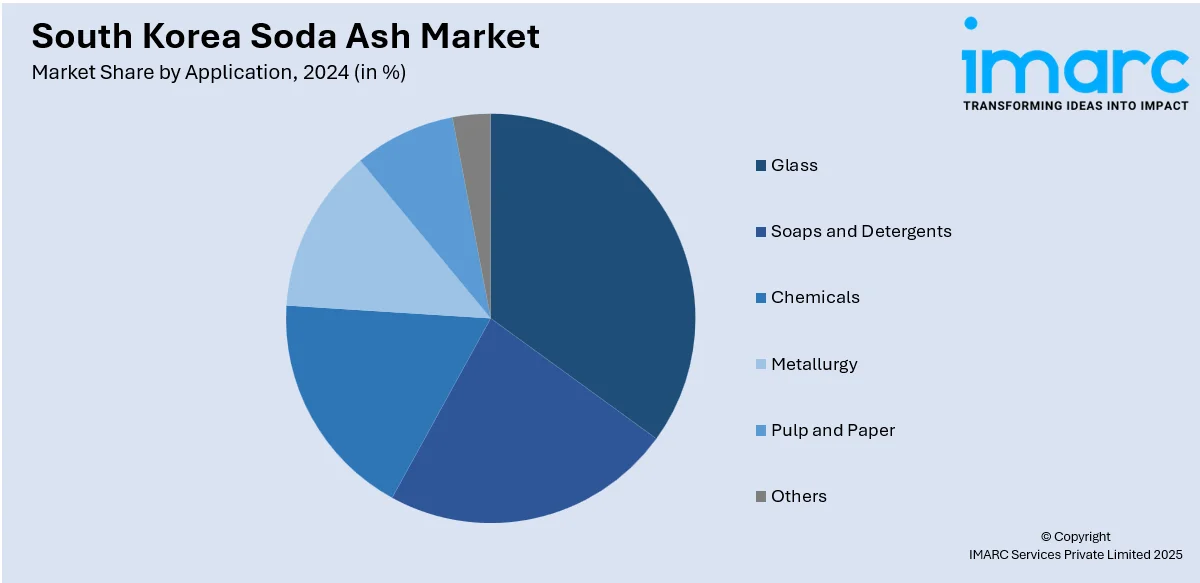
South Korea Soda Ash Market Size, Share, Trends and Forecast by Application, and Region, 2025-2033
South Korea Soda Ash Market Overview:
The South Korea soda ash market size reached USD 394.32 Million in 2024. The market is projected to reach USD 579.46 Million by 2033, exhibiting a growth rate (CAGR) of 4.37% during 2025-2033. The market is poised for steady advancement through its diverse industrial applications, including glass manufacturing, detergents, and chemical processing. A combination of modernization in end-use sectors and rising demand for more sustainable production practices is guiding market dynamics. Domestic producers are enhancing operations through technological upgrades and capacity optimization, while partnerships with global suppliers are refining supply chain efficiency. Supportive environmental regulations and innovation-focused initiatives are further influencing market trajectory, positioning South Korea soda ash market share.
|
Report Attribute
|
Key Statistics
|
|---|---|
|
Base Year
|
2024 |
|
Forecast Years
|
2025-2033
|
|
Historical Years
|
2019-2024
|
| Market Size in 2024 | USD 394.32 Million |
| Market Forecast in 2033 | USD 579.46 Million |
| Market Growth Rate 2025-2033 | 4.37% |
South Korea Soda Ash Market Trends:
Rising Demand from the Glass Manufacturing Sector
The growing construction and automotive sectors in South Korea are driving a significant increase in demand for various types of glass, including flat glass, container glass, and fiberglass of which depend heavily on soda ash as a primary raw material. Architectural glass is becoming more critical to sustainable building designs, with energy efficiency and thermal insulation at the forefront of construction trends. Automotive manufacturers are also transitioning toward lighter and more efficient glass materials, further contributing to rising soda ash consumption. Additionally, the expanding installation of solar panels is encouraging the production of specialty glass, which requires soda ash to enhance clarity and strength. This widening reliance on soda ash across diverse glass applications indicates a strong upward trend in overall consumption. South Korea soda ash market growth is supported by these developments, positioning the country as a prominent player in East Asia’s glass manufacturing landscape. Innovations in energy-efficient glass technologies ensure soda ash remains integral to advanced glass compositions, reflecting an industrial shift toward resource-optimized production methods.

To get more information on this market, Request Sample
Expansion of Detergent and Cleaning Product Applications
South Korea’s household and industrial cleaning product markets have experienced steady growth, fueled by increasing hygiene standards and increased consumer environmental awareness. Soda ash, commonly used as a builder in detergents and a water softening agent, plays a crucial role in these formulations. The shift towards phosphate-free and eco-friendly cleaning products has encouraged manufacturers to leverage soda ash’s non-toxic and biodegradable properties. This change aligns with South Korea’s growing environmental consciousness, encouraging innovation in sustainable product development. Furthermore, the hospitality and food processing sectors demand effective sanitation solutions, driving additional soda ash usage. Regulatory shifts favoring eco-certified, low-impact products further strengthen soda ash’s market position. Reflecting broader South Korea soda ash market trends, these factors collectively promote greener cleaning technologies and reshape consumption patterns in domestic and institutional segments. The evolving demand underscores soda ash’s increasing importance in supporting sustainable chemistry and product innovation, strengthening its foothold in the detergent and cleaning industries.
Adoption in Water Treatment and Environmental Applications
South Korea is intensifying its investments in municipal and industrial water treatment infrastructure to address growing environmental concerns, particularly around water quality and sustainability. Soda ash is widely utilized for its effective pH adjustment capabilities, which are essential in neutralizing acidic water and optimizing coagulation during treatment. This functionality is critical for industries like electronics, semiconductors, and chemicals, where ultra-pure water quality is mandatory. Additionally, tighter emissions and effluent regulations have increased the use of soda ash in flue gas desulfurization and other environmental control processes. These efforts demonstrate a comprehensive environmental commitment, with soda ash playing a key role in enabling regulatory compliance and pollution reduction. As South Korea continues to modernize its environmental management frameworks, the soda ash market is expected to benefit from these sustainability-driven infrastructure upgrades. This evolving role reflects broader South Korea soda ash market growth, highlighting its significance in promoting ecological resilience and long-term environmental health.
South Korea Soda Ash Market Segmentation:
IMARC Group provides an analysis of the key trends in each segment of the market, along with forecasts at the country and regional levels for 2025-2033. Our report has categorized the market based on application.
Application Insights:

- Glass
- Soaps and Detergents
- Chemicals
- Metallurgy
- Pulp and Paper
- Others
A detailed breakup and analysis of the market based on the application have also been provided in the report. This includes glass, soaps and detergents, chemicals, metallurgy, pulp and paper, and others.
Regional Insights:
- Seoul Capital Area
- Yeongnam (Southeastern Region)
- Honam (Southwestern Region)
- Hoseo (Central Region)
- Others
The report has also provided a comprehensive analysis of all the major regional markets, which include the Seoul Capital Area, Yeongnam (Southeastern Region), Honam (Southwestern Region), Hoseo (Central Region), and others.
Competitive Landscape:
The market research report has also provided a comprehensive analysis of the competitive landscape. Competitive analysis such as market structure, key player positioning, top winning strategies, competitive dashboard, and company evaluation quadrant has been covered in the report. Also, detailed profiles of all major companies have been provided.
South Korea Soda Ash Market Report Coverage:
| Report Features | Details |
|---|---|
| Base Year of the Analysis | 2024 |
| Historical Period | 2019-2024 |
| Forecast Period | 2025-2033 |
| Units | Million USD |
| Scope of the Report |
Exploration of Historical Trends and Market Outlook, Industry Catalysts and Challenges, Segment-Wise Historical and Future Market Assessment:
|
| Applications Covered | Glass, Soaps and Detergents, Chemicals, Metallurgy, Pulp and Paper, Others |
| Regions Covered | Seoul Capital Area, Yeongnam (Southeastern Region), Honam (Southwestern Region), Hoseo (Central Region), Others |
| Customization Scope | 10% Free Customization |
| Post-Sale Analyst Support | 10-12 Weeks |
| Delivery Format | PDF and Excel through Email (We can also provide the editable version of the report in PPT/Word format on special request) |
Key Questions Answered in This Report:
- How has the South Korea soda ash market performed so far and how will it perform in the coming years?
- What is the breakup of the South Korea soda ash market on the basis of application?
- What is the breakup of the South Korea soda ash market on the basis of region?
- What are the various stages in the value chain of the South Korea soda ash market?
- What are the key driving factors and challenges in the South Korea soda ash market?
- What is the structure of the South Korea soda ash market and who are the key players?
- What is the degree of competition in the South Korea soda ash market?
Key Benefits for Stakeholders:
- IMARC’s industry report offers a comprehensive quantitative analysis of various market segments, historical and current market trends, market forecasts, and dynamics of the South Korea soda ash market from 2019-2033.
- The research report provides the latest information on the market drivers, challenges, and opportunities in the South Korea soda ash market.
- Porter's five forces analysis assist stakeholders in assessing the impact of new entrants, competitive rivalry, supplier power, buyer power, and the threat of substitution. It helps stakeholders to analyze the level of competition within the South Korea soda ash industry and its attractiveness.
- Competitive landscape allows stakeholders to understand their competitive environment and provides an insight into the current positions of key players in the market.
Need more help?
- Speak to our experienced analysts for insights on the current market scenarios.
- Include additional segments and countries to customize the report as per your requirement.
- Gain an unparalleled competitive advantage in your domain by understanding how to utilize the report and positively impacting your operations and revenue.
- For further assistance, please connect with our analysts.
 Request Customization
Request Customization
 Speak to an Analyst
Speak to an Analyst
 Request Brochure
Request Brochure
 Inquire Before Buying
Inquire Before Buying




.webp)




.webp)












